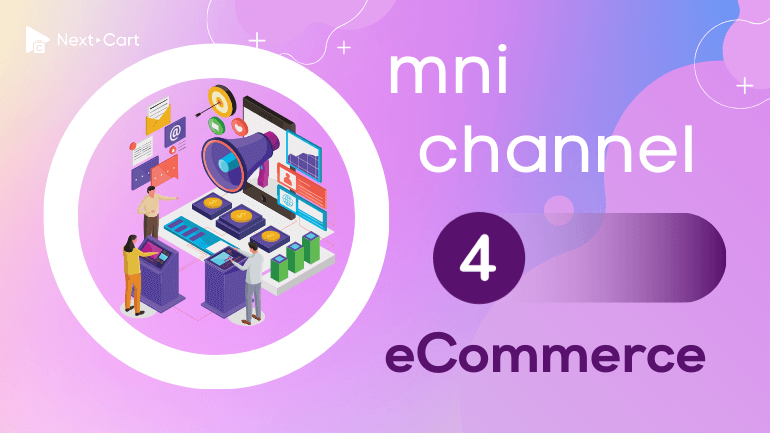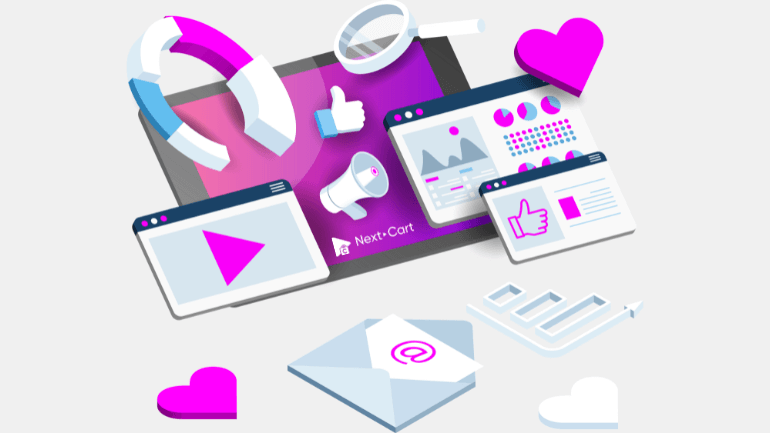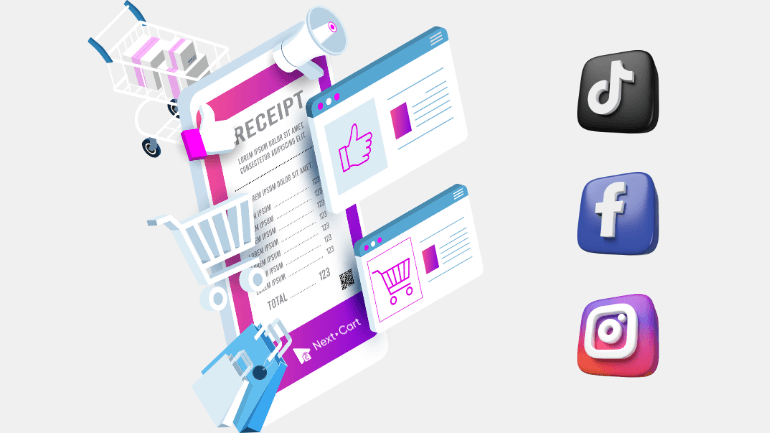
In the dynamic world of shopping online, the omnichannel appears as a significant transformation. Customers today expect seamless transitions across various touchpoints – from engaging with video content on social media to exploring products in physical stores, and from cross-platform research to a spectrum of fulfillment and return options.
For online sellers, it’s crucial to adapt to these evolving consumer expectations by offering customers a consistent, personalized shopping experience across websites, online marketplaces, and social media channels.
Not only accuracy in inventory updates and clear communication on order and delivery status, but also tailored experiences based on customer interaction history are becoming standard expectations. In this landscape, Next-Cart is a pivotal tool for helping to ensure a seamless transition of crucial data during platform migrations – a foundational step in crafting robust omnichannel strategies.
Curious? Keep reading!
Providing a Seamless Customer Experience
Today’s customers expect to be met in their preferred shopping environments. The seller must go beyond a traditional product website by establishing a presence on multiple eCommerce platforms and mobile applications, social media channels, and third-party marketplaces.
Strategic diversification is key to effective engagement and expanded reach across channels offering unique points of interaction. Boutique clothing retailers, for example, will find it advantageous to create integrated shops on social media like TikTok, Instagram and Facebook due to consumer trends favoring social media engagement for product discovery, but at the same time may wish to cater to eBay’s bargain-hunting audience, and Amazon’s Prime members who place a premium on convenience and fast shipping.
Multiple sales channels management
However, managing multiple sales channels makes it harder to maintain the consistency needed to provide a seamless customer experience. Data integration is the cornerstone of successful omnichannel retailing. It involves harmonizing customer data from various channels to create a unified view. For instance, a new product line in the Shopify store should be automatically updated across social media and Amazon listings.
Next-Cart enables the transfer of product information, customer data, and historical transactions, preserving the integrity of the customer experience when migrating to new platforms.
Promotional strategies

Omnichannel – Promotional strategies
It is critical that the retailer maintains consistent product information, pricing, imagery, and promotional activities across all these channels. For instance, when a specialty home décor seller promotes a lighting fixture promoted on Instagram, the customer should be able to find identical product details and pricing when the same item is viewed on Amazon, eBay and the company’s main website in order to mitigate customer confusion and foster brand credibility.
Promotional strategies executed on the primary website, such as discounts or bundled offers, should be uniformly represented on all digital sales channels. This alignment not only streamlines the customer journey but also consolidates the brand’s messaging.
The retailer must ensure that customer service standards are equivalent across all platforms. Queries and concerns raised on any channel should be addressed with consistent responsiveness and resolution quality, reinforcing a seamless and professional brand experience.
Competitive Cross-Platform Inventory management

Omnichannel – Cross-Platform Inventory management
Retail operations become increasingly complex and crucial as businesses expand across multiple online platforms. The most significant factor in promoting customer satisfaction is effective cross-platform inventory management. Regular updates and accurate inventory data are instrumental in averting complications such as overselling.
They also instill confidence in customers regarding product availability. When a customer places an order, they do so with the expectation that the item is immediately available for shipping. Meeting these expectations consistently enhances customer trust in the brand and reduces the likelihood of customer service complications arising from stock discrepancies. Effective inventory management also involves strategic planning to anticipate demand, especially during peak seasons or promotional events, and to adjust inventory accordingly.
To maintain data integrity, the starting point is effective initial synchronization during a platform migration. Accurate transfer of product information during a migration ensures the maintenance of the data integrity which is vital to post-migration inventory management. Accurate data is important to have flexibility in decisions about platform Integration. If a retailer decides to switch to a platform that offers better inventory management features, a migration tool like Next-Cart can facilitate this transition smoothly.
Increase retention with customer service
One of the ways in which it is most important for smaller online sellers to compete with big players is to provide a standout customer service experience. Online retailers must have systems in place that enable quick and consistent responses to customer inquiries, regardless of whether they come from live chat, direct messages from different platforms, or emails.
An online retailer might employ a system that aggregates inquiries from different channels into a single dashboard with a ticketing process with which each inquiry can be tracked and resolved. Integrating AI-driven chatbots for common queries, like order status or product details, can enhance responsiveness, but it is also essential to provide an easy option for customers to escalate more complex issues to a human representative.
Versatile fulfillment
Providing versatile order fulfillment options is equally crucial for maintaining a competitive edge. Retailers, particularly those operating primarily online, face the challenge of meeting diverse customer expectations for delivery and pickup options. They should offer a range of choices, including home delivery, in-store or curbside pickup, and even same-day delivery where feasible. Where possible, integrating a local pickup option can attract customers who are nearby and prefer a quicker, more direct method of receiving their products, particularly for items that are bulky or very expensive.
However, these flexible fulfillment options come with their own set of challenges. Managing logistics across multiple channels can be complex. It involves ensuring inventory availability for both online orders and in-store pickups, coordinating with shipping partners for timely deliveries, and efficiently handling returns and exchanges. Moreover, maintaining consistency in customer experience across different fulfillment methods is critical. Whether a customer chooses home delivery or curbside pickup, the service level should be uniformly high.
Technology plays a pivotal role in streamlining these processes. Implementing an integrated order management system can help track orders from placement to delivery, irrespective of the chosen fulfillment method. This system should also provide real-time inventory visibility to prevent over-selling and ensure that orders are fulfilled accurately and promptly.
Operational feasibility
For online retailers, the key is to balance customer expectations with operational feasibility. They need to establish strong logistics partnerships, leverage technology for inventory and order management, and continually assess and adapt their fulfillment strategies based on customer feedback and market trends.
The return policy should be transparent and easily accessible on the retailer’s website. It should clearly outline the time frame within which returns or exchanges are accepted, the condition in which items need to be returned, and the process for receiving refunds or store credits. Providing a FAQ section on the website dedicated to returns and exchanges can also help address common customer queries.
Additionally, integrating the returns process with the inventory management system is important for real-time updating of stock levels. When an item is returned, the system should automatically reflect this, making the item available for resale. Retailers should also consider using return data analytics to identify trends and insights, such as common reasons for returns, which can inform future product development or enhancements in customer service strategies.
Choosing the Right Platforms for Omnichannel Sales
Common choices
Many retailers prefer Shopify, or, in some cases Squarespace or Wix, for their simplicity and ease of use. Shopify allows tracking and updating stock levels, setting up low stock alerts, and managing product variants as well as bulk import/export functionality for inventory updates, and it integrates with various sales channels like Facebook, Instagram, and Amazon.
Squarespace also includes basic inventory management tools suitable for smaller retailers. These tools allow for tracking inventory levels, setting stock alerts, and managing product variants. Squarespace’s eCommerce plans also integrate with Instagram.
Wix eCommerce offers user-friendly inventory management suitable for small businesses. Retailers can track inventory, receive low stock notifications, and manage product options. Additionally, Wix allows integration with other sales channels, providing a unified approach to inventory across various platforms.
Those already using WordPress will want to consider the WooCommerce plugin, which offers inventory management capabilities such as stock level tracking, low stock notifications, and handling of product variations. WooCommerce allows for extensive customization, including integration with other tools and plugins for enhanced inventory management.
For enterprise
Larger businesses may need platforms with more advanced features and scalability. Adobe Commerce (formerly Magento) offers a comprehensive set of inventory management tools including advanced stock management, batch import/export of inventory data, detailed inventory reports, and multi-source inventory capabilities for managing stock across multiple locations. BigCommerce provides features including stock level tracking, low stock alerts, and bulk inventory management and integrates with marketplaces like eBay and Amazon.
Social store

Omnichannel – Social stores
Social media stores offer basic inventory management features but can also be integrated with many of the platforms listed above. Most established are Facebook Shops and Instagram Shopping, which allow businesses to create customizable digital storefronts directly on their Facebook and Instagram pages, supporting tagging and links in posts and stories, and has some built-in inventory management features. Facebook Shops and Instagram Shopping also integrate with platforms like Shopify and BigCommerce, allowing for synchronized inventory management.
For some market niches, other social media platforms may also be relevant. Pinterest remains useful for driving traffic in some nice areas such as home decor, DIY, fashion, and recipes, though it is less commonly used for sales. Snapchat has a feature called Shopping Lenses which uses augmented reality to allow users to virtually try on or interact with products. This can be effective marketing in areas like fashion, cosmetics, and accessories, where seeing a product in a real-world context can influence purchasing decisions.
The most exciting trending social commerce platform is TikTok, which has introduced features that allow businesses to showcase and sell products directly within the app. TikTok Shop enables merchants to integrate their product catalog to allow direct sales either from their TikTok profile or through in-video links. TikTok has started introducing live shopping features, where creators can sell products during live broadcasts.
Store integration
eCommerce platforms have started to offer direct integration with TikTok, though this is in its early stages. Shopify users can connect their store directly to TikTok, enabling them to create and run TikTok ad campaigns and showcase products. They may be able to use TikTok’s Shopping tab features depending on the available functionalities in their region to sync their product catalogs directly with their TikTok business account. BigCommerce integration includes the ability to sync product catalogs and create shoppable ad campaigns directly from the BigCommerce platform. Wix allows businesses to connect their Wix online store with TikTok, allowing for the creation of TikTok ad campaigns. Ecwid by Lightspeed users can also integrate with TikTok to extend their marketing and promotional reach. Third-party plugins and tools are available for WooCommerce marketing integration. Similarly, Squarespace users may use TikTok marketing to generate traffic to their stores. TikTok offers a tool for tracking user interactions on their website from TikTok ads, the TikTok Pixel, so retailers can understand customer behavior.
To sum up,
In the ever-changing landscape of online retail, embracing omnichannel strategies is crucial for retailers to thrive. Tools like Next-Cart play a significant role in this evolution by facilitating data integration during platform migrations. By expanding across multiple sales channels, ensuring consistency in the customer experience, managing inventory effectively, providing excellent customer service, offering flexible order fulfillment and returns, and leveraging personalization, retailers can create a competitive edge. As the digital age progresses, retailers who adopt and refine their omnichannel strategies will be best positioned to meet customer expectations and drive business growth.